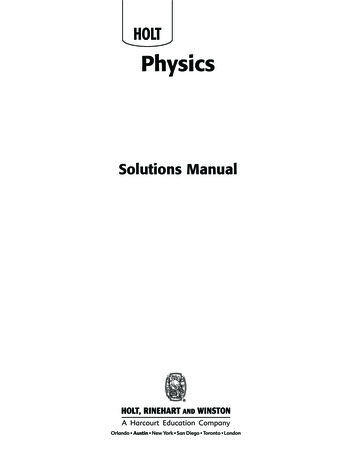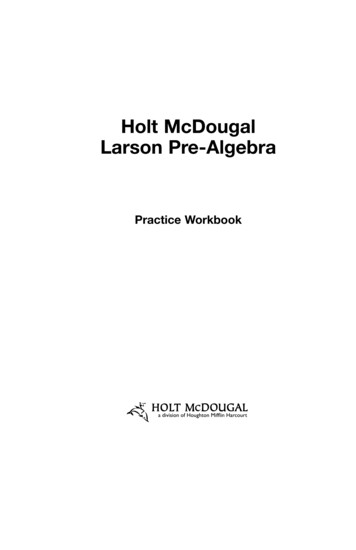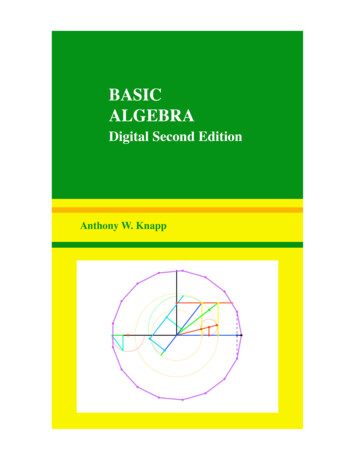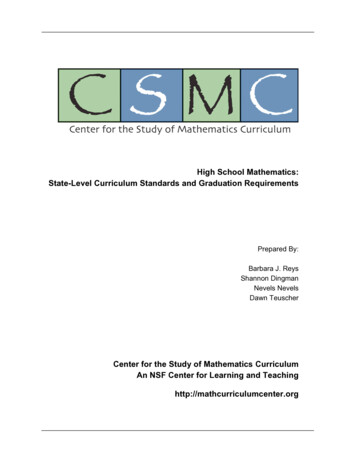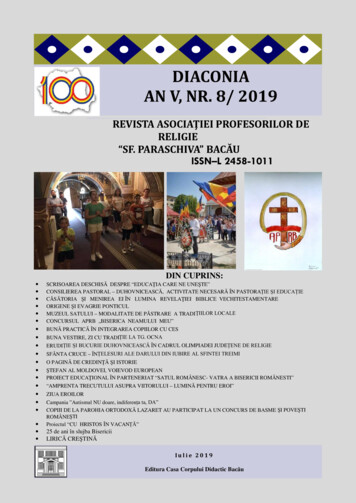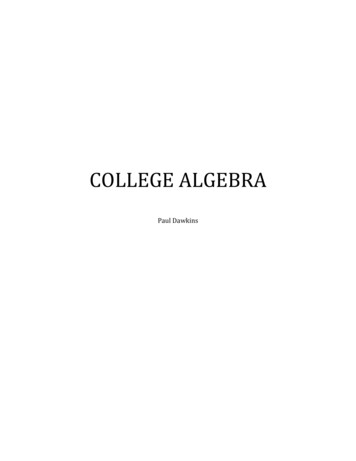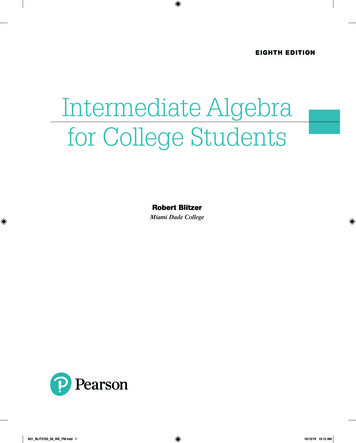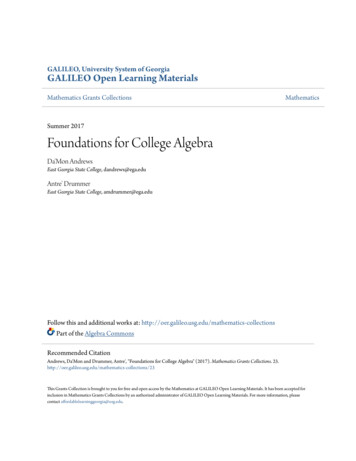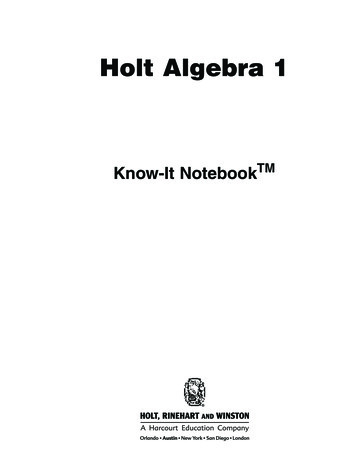
Transcription
Holt Algebra 1Know-It NotebookTM
Copyright by Holt, Rinehart and WinstonAll rights reserved. No part of this publication may be reproduced or transmitted in any form or by anymeans, electronic or mechanical, including photocopy, recording, or any information storage and retrievalsystem, without permission in writing from the publisher.Requests for permission to make copies of any part of the work should be mailed to the followingaddress: Permissions Department, Holt, Rinehart and Winston, 10801 N. MoPac Expressway, Building 3,Austin, Texas 78759.HOLT and the “Owl Design” are trademarks licensed to Holt, Rinehart and Winston, registered in theUnited States of America and/or other jurisdictions.Printed in the United States of AmericaIf you have received these materials as examination copies free of charge, Holt, Rinehartand Winston retains title to the materials and they may not be resold. Resale ofexamination copies is strictly prohibited.Possession of this publication in print format does not entitle users to convert thispublication, or any portion of it, into electronic format.ISBN 0-03-077923-51 2 3 4 5 6 7 8 986209 08 07 06Copyright by Holt, Rinehart and Winston. All rights reserved.
ContentsUsing KINNotetaking StrategiesChapter 1 Key VocabularyLesson 1-1Lesson 1-2Lesson 1-3Lesson 1-4Lesson 1-5Lesson 1-6Lesson 1-7Lesson 1-8Chapter 1 ReviewChapter 1 Big Idea QuestionsChapter 2 Key VocabularyLesson 2-1Lesson 2-2Lesson 2-3Lesson 2-4Lesson 2-5Lesson 2-6Lesson 2-7Lesson 2-8Lesson 2-9Lesson 2-10Chapter 2 ReviewChapter 2 Big Idea QuestionsChapter 3 Key VocabularyLesson 3-1Lesson 3-2Lesson 3-3Lesson 3-4Lesson 3-5Lesson 3-6Chapter 3 ReviewChapter 3 Big Idea QuestionsChapter 4 Key VocabularyLesson 4-1Lesson 4-2Lesson 4-3Lesson 4-4Lesson 4-5Lesson 4-6Chapter 4 ReviewChapter 4 Big Idea QuestionsChapter 5 Key VocabularyLesson 5-1Lesson 5-2Lesson 5-3Lesson 5-4Lesson 5-5Lesson 5-6Lesson 5-7Lesson 5-8Lesson 5-9Chapter 5 ReviewChapter 5 Big Idea QuestionsChapter 6 Key VocabularyLesson 6-1Lesson 6-2Lesson 6-3Lesson 6-4Lesson 6-5Lesson 6-6Chapter 6 ReviewChapter 6 Big Idea QuestionsCopyright by Holt, Rinehart and Winston.All rights 78798081828486919294959698100101102105Chapter 7 Key VocabularyLesson 7-1Lesson 7-2Lesson 7-3Lesson 7-4Lesson 7-5Lesson 7-6Lesson 7-7Lesson 7-8Chapter 7 ReviewChapter 7 Big Idea QuestionsChapter 8 Key VocabularyLesson 8-1Lesson 8-2Lesson 8-3Lesson 8-4Lesson 8-5Lesson 8-6Chapter 8 ReviewChapter 8 Big Idea QuestionsChapter 9 Key VocabularyLesson 9-1Lesson 9-2Lesson 9-3Lesson 9-4Lesson 9-5Lesson 9-6Lesson 9-7Lesson 9-8Lesson 9-9Chapter 9 ReviewChapter 9 Big Idea QuestionsChapter 10 Key VocabularyLesson 10-1Lesson 10-2Lesson 10-3Lesson 10-4Lesson 10-5Lesson 10-6Lesson 10-7Lesson 10-8Chapter 10 ReviewChapter 10 Big Idea QuestionsChapter 11 Key VocabularyLesson 11-1Lesson 11-2Lesson 11-3Lesson 11-4Lesson 11-5Lesson 11-6Lesson 11-7Lesson 11-8Lesson 11-9Chapter 11 ReviewChapter 11 Big Idea QuestionsChapter 12 Key VocabularyLesson 12-1Lesson 12-2Lesson 12-3Lesson 12-4Lesson 12-5Lesson 12-6Lesson 12-7Chapter 12 ReviewChapter 12 Big Idea 7208211Algebra 1
USING THE KNOW-IT NOTEBOOK This Know-It Notebook will help you take notes, organize your thinking, and studyfor quizzes and tests. There are Know-It Notes pages for every lesson in yourtextbook. These notes will help you identify important mathematical information thatyou will need later.Know-It NotesVocabularyOne good note-taking practice is to keep a list of the new vocabulary. Use the page references or the glossary in your textbook to find each definitionand a clarifying example. Write each definition and example on the lines provided.Lesson ObjectivesAnother good note-taking practice is to know the objective the content covers.Additional ExamplesYour textbook includes examples for each math concept taught. Additional examplesin the Know-It Notebook help you take notes to remember how to solve differenttypes of problems. Take notes as your teacher discusses each example. Write notes in the blank boxes to help you remember key concepts. Write final answers in the shaded boxes.Check It OutComplete the Check It Out problems that follow each lesson. Use these to make sureyou understand the math concepts covered in the lesson. Write each answer in the space provided. Check your answers with your teacher or another student. Ask your teacher to help you understand any problem that you les and ExpressionsLESSON 1-1 CONTINUED1-1This table contains important vocabulary terms from Chapter 1. As you workthrough the chapter, fill in the page number, definition, and a clarifying examplefor each term.Lesson ObjectivesTranslate between words and algebra; Evaluate algebraic expressions.To make 20 sleeping bags, 1700bottles are needed.To make 50 sleeping bags, 4250bottles are needed.VocabularyTermabsolute valuePage14additive te plane 54DefinitionThe distance of anumber from zero onthe number line.Clarifying Exampleletter or symbol used to represent a value that can change.variable (p. 6) A冷2冷 2冷 2冷 2value that does not change.constant (p. 6) ASubtracting 6 is thesame as adding theinverse of 6, 6.An expression that may x 4contain variables,constants, andoperations.1. Give two ways to write the algebraic expression in words.operations.An expression that may contain variables, constantsalgebraic expression (p. 6)andoperations. X26The number that tellsIn the expression 54, 4how many times theis the exponent.base is used as a factorin a power.integers34The whole numbersand their opposites.irrationalnumbers34Numbers that cannot be 兹2苶, 兹11苶, aexpressed in the form ᎏbᎏincluding square rootsof whole numbers thatare not perfect squaresand nonterminatingdecimals that do notrepeat.Copyright by Holt, Rinehart and Winston.All rights reserved.Terms that contain thesame variables raisedto the same powers.4., 3, 2, 1, 0, 1, 2,3, .32dp–nExample 1exponent474 decreased by nn less than 42. Elaine earns 32 per day. Write an expression for the amount thatshe earns in d days.3. Evaluate the expression for m 3, n 2, and p 9.Additional Examplesn n like terms4 nTo find the value of an expression.evaluate (p. 7)Y n Check It Out!An expression that may contain only constants andnumerical expression (p. 6)A number multiplied by In the expression 3x,a variable.3 is the coefficient.n bottles are needed.The opposite of anumber used whensubtracting numbers.Formed by theintersection of twoperpendicular numberlines.To make 325 sleeping bags, 27,625Give two ways to write each algebraic expression in words.7A. 9 r4. To make one sweater, sixty-three 20-ounce plastic drink bottles mustbe recycled.the sum of 9 and rWrite an expression for the number of bottles needed to makes sweaters.9 increased by rB. q 363sthe difference of q and 33 less than q4x and 3xAlgebra 1Copyright by Holt, Rinehart and Winston.All rights reserved.Copyright by Holt, Rinehart and Winston.All rights reserved.6ivAlgebra 1Copyright by Holt, Rinehart and Winston.All rights reserved.9Algebra 1Algebra 1
Key ConceptsKey concepts from each lesson are included. These are indicated in your studentbook with the KIN logo. Write each answer in the space provided. Check your answers with your book. Ask your teacher to help you with any concept that you don’t understand.Chapter ReviewComplete Chapter Review problems that follow each lesson. This is a good reviewbefore you take the chapter test. Write each answer in the space provided. Check your answers with your teacher or another student. Ask your teacher to help you understand any problem that you answeredincorrectly.Big IdeasThe Big Ideas have you summarize the important chapter concepts in your ownwords. Putting ideas in your words requires that you think about the ideas andunderstand them. This will also help you remember them. Write each answer in the space provided. Check your answers with your teacher or another student. Ask your teacher to help you understand any question that you answeredincorrectly.LESSON 1-1 CONTINUEDCHAPTERChapter ReviewCHAPTER1Big Ideas1Key ConceptsAnswer these questions to summarize the important concepts fromChapter 1 in your own words.1-1 Variables and ExpressionsThink and Discuss (p. 8)Evaluate each expression for a 3, b 4, and c 8.Get Organized Next to each operation, write a word phrase in the left box andits corresponding algebraic expression in the right box.WORDSALGEBRA1. a b72. ac3. c b44. c b1. Explain how adding numbers with the same sign is different from addingnumbers with different signs.242When adding numbers with the same sign, add their absolutevalues and use the sign of the numbers. When adding numberswith different signs, find their difference of their absolute valuesand use the sign of the number with the greater absolute value.5. Amy runs 3 miles each day.3 more than xAdditionx 31 less than ySubtractiony 1The product of 2and nMultiplication2na. Write an expression for the number of miles Amy runs in d days.3db. Find the number of miles Amy runs in 5, 10, and 32 days.2. Explain the relationship between square roots and perfect squares.15, 30, 96The operations of squaring and finding a square root are inverseoperations.1-2 Adding and Subtracting Real NumbersDivisionx 43. Explain why is an irrational number.Add or subtract.The quotient of xand 4 76.76. 15.3 61.48. 72 ( 38)341ᎏᎏ9417. ᎏ9ᎏ ᎏ3ᎏ9. 6.4 9.8aAn irrational number cannot be expressed in the form ᎏbᎏ. is an 3.4airrational number because it cannot be expressed in the form ᎏbᎏ.10. Sue had 78.25. She spent 25.65. How much does she have left?4. Explain how to graph the point ( 5, 7). 52.601-3 Multiplying and Dividing Real NumbersStart at the origin. Move 5 units left and 7 units up.Multiply or divide.11. 2.3(10)13. 64 ( 8) 23 85. How are natural numbers and whole numbers alike and different?112. 2 ᎏ3ᎏ614. 4(12)48Natural numbers and whole numbers both include countingnumbers. Whole numbers also include zero.15. There were 183 people at a basketball game. Each ticket cost 8. Howmuch money was spent on the tickets for the basketball game?For more review of Chapter 1: Complete the Chapter 1 Study Guide and Review on pages 62–65 of yourtextbook. 1464 Complete the Ready to Go On quizzes on pages 39 and 61 of yourtextbook.Copyright by Holt, Rinehart and Winston.All rights reserved.10Algebra 1Copyright by Holt, Rinehart and Winston.Copyright by Holt, Rinehart and Winston.All rights reserved.52Algebra 11Copyright by Holt, Rinehart and Winston.All rights reserved.55Algebra 1Algebra 1
NOTE TAKING STRATEGIESTaking good notes is very important in many of your classes and will be evenmore important when you take college classes. This Notebook was designed tohelp you get started. Here are some other steps that can help you take goodnotes.Getting Ready1. Use a loose-leaf notebook. You can add pages to this as where and whenyou want to. It will help keep you organized.During the Lecture2. If you are taking notes during a lecture, write the big ideas. Useabbreviations to save time. Do not worry about spelling or writing everyword. Use headings to show changes in the topics discussed. Usenumbering or bullets to organize supporting ideas under each topicheading. Leave space before each new heading so that you can fill in moreinformation later.After the Lecture3. As soon as possible after the lecture, read through your notes and add anyinformation you can so that when you review your notes later, they makesense. You should also summarize the information into key words or keyphrases. This will help your comprehension and will help you process theinformation. These key words and key phrases will be your memory cueswhen you are reviewing or taking a test. At this time you may also want towrite questions to help clarify the meaning of the ideas and facts.4. Read your notes out loud. As you do this, state the ideas in your own wordsand do as much as you can by memory. This will help you remember andwill also help with your thinking process. It helps you think about andunderstand the information.5. Reflect upon the information you have learned. Ask yourself how newinformation relates to information you already know. Ask how this relates toyour personal experience. Ask how you can apply this information and whyit is important.Copyright by Holt, Rinehart and Winston.All rights reserved.2Algebra 1
Before the Test6. Review your notes. Don’t wait until the night before the test to do this review.Do frequent reviews. Don’t just read through your notes. Put the informationin your notes into your own words. If you do this you will be able to connectthe new material with material you already know. You will be better preparedfor tests. You will have less test anxiety and will have better recall.7. Summarize your notes. This should be in your own words and should onlyinclude the main points that you need to remember. This will help youinternalize the information.Copyright by Holt, Rinehart and Winston.All rights reserved.3Algebra 1
CHAPTERVocabulary1This table contains important vocabulary terms from Chapter 1. As you workthrough the chapter, fill in the page number, definition, and a clarifying examplefor each term.TermPageDefinitionClarifying Exampleabsolute valueadditive inversealgebraicexpressioncoefficientcoordinate planeexponentintegersirrationalnumberslike termsCopyright by Holt, Rinehart and Winston.All rights reserved.4Algebra 1
CHAPTER 1 VOCABULARY CONTINUEDTermPageDefinitionClarifying lexpressionordered pairrationalnumbersreal numbersreciprocalwhole numbersx-coordinatey-coordinateCopyright by Holt, Rinehart and Winston.All rights reserved.5Algebra 1
LESSONVariables and Expressions1-1Lesson ObjectivesTranslate between words and algebra; Evaluate algebraic expressions.Vocabularyvariable (p. 6)constant (p. 6)numerical expression (p. 6)algebraic expression (p. 6)evaluate (p. 7)Key ConceptsThink and Discuss (p. 8)Get Organized Next to each operation, write a word phrase in the left box andits corresponding algebraic expression in the right ivisionCopyright by Holt, Rinehart and Winston.All rights reserved.6Algebra 1
LESSONAdding and Subtracting Real Numbers1-2Lesson ObjectivesAdd real numbers; Subtract real numbersVocabularyabsolute value (p. 14)opposites (p. 15)additive inverse (p. 15)Key ConceptsAdding Real Numbers (p. 15):WORDSNUMBERSAdding Numbers with the SameSignAdding Numbers with DifferentSignsSubtracting Real Numbers (p. 15):WORDSCopyright by Holt, Rinehart and Winston.All rights reserved.NUMBERS7ALGEBRAAlgebra 1
LESSON 1-2 CONTINUEDThink and Discuss (p. 17)Get Organized For each pair of points, tell whether the sum and the differenceof the first point and the second point are positive or negative.!" #POINTS SUMDIFFERENCEA, BB, AC, BD, ACopyright by Holt, Rinehart and Winston.All rights reserved.8Algebra 1
LESSONMultiplying and Dividing Real Numbers1-3Lesson ObjectivesMultiply real numbers; Divide real numbersVocabularyreciprocal (p. 21)multiplicative inverse (p. 21)Key ConceptsMultiplying and Dividing Signed Numbers (p. 21):WORDSNUMBERSMultiplying and Dividing Numberswith the Same SignMultiplying and Dividing Numberwith Different SignsProperties of Zero (p. 21):WORDSNUMBERSALGEBRAMultiplication by ZeroZero Divided by aNumberDivision by ZeroCopyright by Holt, Rinehart and Winston.All rights reserved.9Algebra 1
LESSON 1-3 CONTINUEDThink and Discuss (p. 22)Get Organized In each blank, write “pos” or “neg” to indicate positive ornegative.Multiplying and Dividing NumbersMULTIPLICATIONDIVISIONpos pospos pospos negpos negneg negneg negneg posneg posCopyright by Holt, Rinehart and Winston.All rights reserved.10Algebra 1
LESSONPowers and Exponents1-4Lesson ObjectivesEvalute expressions containing exponentsVocabularypower (p. 26)base (p. 26)exponent (p. 26)Key ConceptsThink and Discuss (p. 28)Get Organized In each box, give an example and tell whether the expression ispositive or negative.Even ExponentOdd ExponentPositive BaseNegative BaseCopyright by Holt, Rinehart and Winston.All rights reserved.11Algebra 1
LESSONSquare Roots and Real Numbers1-5Lesson ObjectivesEvaluate expressions containing square roots; Classify numbers within the realnumber systemVocabularysquare root (p. 32)perfect square (p. 32)real numbers (p. 34)natural numbers (p. 34)whole numbers (p. 34)integers (p. 34)rational numbers (p. 34)terminating decimal (p. 34)repeating decimal (p. 34)irrational numbers (p. 34)Copyright by Holt, Rinehart and Winston.All rights reserved.12Algebra 1
LESSON 1-5 CONTINUEDKey ConceptsReal Numbers (p. 34):27 3Rational Numbers (Q)10Integers (Z) 3Whole Numbers (W) 110.3 Irrational Numbers 2 170 11 Natural Numbers (N)1 23 24.5e27 3Think and Discuss (p. 35)Get Organized Use the flowchart to classify each of the given numbers. Writeeach number in the box with the most specific classification that applies. 4, 25 ,110, 3 , 15, 2.25, 4 , 21 , 24, ( 1)2IRRATIONAL NUMBERNoRATIONAL NUMBERYesINTEGERYesNoCopyright by Holt, Rinehart and Winston.All rights reserved.WHOLENUMBERNoYesNATURALNUMBERNo13Algebra 1
LESSONOrder of Operations1-6Lesson ObjectivesUse the order of operations to simplify expressionsVocabularyorder of operations (p. 40)Copyright by Holt, Rinehart and Winston.All rights reserved.14Algebra 1
LESSON 1-6 CONTINUEDKey ConceptsOrder of Operation (p. 40):Order of OperationsFirst:Second:Third:Fourth:Think and Discuss (p. 42)Get Organized In each box, show how grouping symbols can be placed so thatthe expression is equal to the number shown.20 3 2 595Copyright by Holt, Rinehart and Winston.All rights reserved. 52715Algebra 1
LESSONCombining Like Terms1-7Lesson ObjectivesUse the Commutative, Associative, and Distributive Properties to simplifyexpressions; Combine like termsVocabularyterm (p. 47)like terms (p. 47)coefficient (p. 48)Copyright by Holt, Rinehart and Winston.All rights reserved.16Algebra 1
LESSON 1-7 CONTINUEDKey ConceptsProperties of Addition and Multiplication (p. 46):WORDSNUMBERSALGEBRANUMBERSALGEBRACommutative PropertyAssociative PropertyDistributive Property (p. 47):WORDSThink and Discuss (p. 49)Get Organized In each box, give an example to illustrate the given property.AssociativeCopyright by Holt, Rinehart and Winston.All rights reserved.Commutative17DistributiveAlgebra 1
LESSONIntroduction to Functions1-8Lesson ObjectivesGraph ordered pairs in the coordinate plane; Graph functions from ordered pairsVocabularycoordinate plane (p. 54)axes (p. 54)origin (p. 54)x-axis (p. 54)y-axis (p. 54)ordered pair (p. 54)x-coordinate (p. 54)y-coordinate (p. 54)quadrant (p. 54)input (p. 55)output (p. 55)Copyright by Holt, Rinehart and Winston.All rights reserved.18Algebra 1
LESSON 1-8 CONTINUEDKey ConceptsThink and Discuss (p. 56)Get Organized In each blank, write “positive” or “negative.”Quadrant IIQuadrant Ix is.y is.x is.y is.TheCoordinatePlaneQuadrant IIICopyright by Holt, Rinehart and Winston.All rights reserved.x is.y is.x is.y is.Quadrant IV19Algebra 1
CHAPTERChapter Review11-1 Variables and ExpressionsEvaluate each expression for a 3, b 4, and c 8.1. a b2. ac3. c b4. c b5. Amy runs 3 miles each day.a. Write an expression for the number of miles Amy runs in d days.b. Find the number of miles Amy runs in 5, 10, and 32 days.1-2 Adding and Subtracting Real NumbersAdd or subtract.6. 15.3 61.4417. 9 3 8. 72 ( 38)9. 6.4 9.810. Sue had 78.25. She spent 25.65. How much does she have left?1-3 Multiplying and Dividing Real NumbersMultiply or divide.111. 2.3(10)12. 2 3 13. 64 ( 8)14. 4(12)15. There were 183 people at a basketball game. Each ticket cost 8. Howmuch money was spent on the tickets for the basketball game?Copyright by Holt, Rinehart and Winston.All rights reserved.20Algebra 1
CHAPTER 1 REVIEW CONTINUED1-4 Powers and ExponentsWrite each number as a power of the given base.16. 16; base 217. 1024; base 418. 625; base 519. 27; base 320. A certain species started with two and doubled every day. How many specieswere there after 8 days?1-5 Square Roots and Real NumbersCompare. Write21. 121 23. 9, , or .10 100 22. 1124. 6 144 36 25. Brian’s square pool has an area of 124 ft 2. Estimate the side length of hispool.1-6 Order of OperationsEvaluate each expression for the given value of x.26. x 5(4) for x 627. x 2(9 2) for x 328. 4x 2(7) 1 for x 1429. 5( x 2 8) for x 230. A basketball player’s total points can be found by using the expression1f 2j 3t. Diana made 85 foul shots (f ), 106 jump shots (j), and 39 threepointers (t ) last season. How many points did she score?Copyright by Holt, Rinehart and Winston.All rights reserved.21Algebra 1
CHAPTER 1 REVIEW CONTINUED1-7 Simplifying ExpressionsSimplify each expression by combining like terms.31. 8x 2 4x32. 12p 15p33. 6(5 y) 5y34. a 5(2a a 2)Write each product using the Distributive Property. Then simplify.35. 5(47)36. 12(104)37. 11(97)38. 7(83)1-8 Introduction to FunctionsGenerate ordered pairs for each function using the given values for x.39. y 3x 2 2; x 1, 0, 240. y 8 2x; x 1, 0, 141. The initial cost of renting a car is 50 plus 0.25 per mile at Rent-A-Car. Writea rule for the cost of renting a car from Rent-A-Car. Write ordered pairs forthe cost of renting a car and driving 50, 100, and 150 miles.Copyright by Holt, Rinehart and Winston.All rights reserved.22Algebra 1
CHAPTERBig Ideas1Answer these questions to summarize the important concepts fromChapter 1 in your own words.1. Explain how adding numbers with the same sign is different from addingnumbers with different signs.2. Explain the relationship between square roots and perfect squares.3. Explain why is an irrational number.4. Explain how to graph the point ( 5, 7).5. How are natural numbers and whole numbers alike and different?For more review of Chapter 1: Complete the Chapter 1 Study Guide and Review on pages 62–65 of yourtextbook. Complete the Ready to Go On quizzes on pages 39 and 61 of yourtextbook.Copyright by Holt, Rinehart and Winston.All rights reserved.23Algebra 1
CHAPTERVocabulary2The table contains important vocabulary terms from Chapter 2. As you workthrough the chapter, fill in the page number, definition, and a clarifying example.TermPageDefinitionClarifying espondinganglescorrespondingsidescross opyright by Holt, Rinehart and Winston.All rights reserved.24Algebra 1
CHAPTER 2 VOCABULARY CONTINUEDTermPageDefinitionClarifying rcentincreaseprincipleproportionrateratiosales ight by Holt, Rinehart and Winston.All rights reserved.25Algebra 1
Solving Equations by Adding or2-1 SubtractingLESSONLesson ObjectivesSolve one-step equations in one variable by using addition or subtractionVocabularyequation (p. 77)solution of an equation (p. 77)Key ConceptsProperties of Equality (p. 79):WORDSNUMBERSALGEBRAAddition Property of EqualitySubtraction Property of EqualityThink and Discuss (p. 79)Get Organized In each box, write an example of an equation that can besolved by using the given property, and solve it.Propertiesof Equality Copyright by Holt, Rinehart and Winston.All rights reserved. 26Algebra 1
Solving Equations by Multiplying or2-2 DividingLESSONLesson ObjectivesSolve one-step equations in one variable by using multiplication or divisionKey ConceptsProperty of Equality (p. 86):WORDSNUMBERSALGEBRAAddition Property of EqualitySubtraction Property of EqualityMultiplication Property of EqualityDivision Property of EqualityCopyright by Holt, Rinehart and Winston.All rights reserved.27Algebra 1
LESSON 2-2 CONTINUEDThink and Discuss (p. 87)Get Organized In each box, write an example of an equation that can besolved by using the given property, and solve it.Propertiesof EqualityCopyright by Holt, Rinehart and Winston.All rights reserved.28Algebra 1
Solving Two-Step and Multi-Step2-3 EquationsLESSONLesson ObjectivesSolve equations in one variable that contain more than one operationKey ConceptsThink and Discuss (p. 95)Get Organized In each box, write and solve a multi-step equation. Useaddition, subtraction, multiplication, and division at least one time each.Solving Multi-Step EquationsCopyright by Holt, Rinehart and Winston.All rights reserved.29Algebra 1
Solving Equation with Variables on2-4 Both SidesLESSONLesson ObjectivesSolve equations in one variable that contain variable terms on both sidesVocabularyidentity (p. 101):contradiction (p. 101):Key ConceptsIdentities and Contradictions (p. 101):WORDSNUMBERSALGEBRAIdentityContradictionThink and Discuss (p. 103)Get Organized In each box, write an equation that has the indicated numberof solutions.An equation with variableson both sides can have. . .Copyright by Holt, Rinehart and Winston.All rights reserved.30Algebra 1
LESSONSolving for a Variable2-5Lesson ObjectivesSolve a formula for a given variable; Solve an equation in two or more variablesfor one of the variablesVocabularyformula (p. 107):literal equation (p. 108):Key ConceptsSolving for a Variable (p. 107):Solving for a VariableStep 1Step 2Step 3Think and Discuss (p. 109)Get Organized Write a formula that is used in each subject. Then solve theformula for each of its variables.Common scienceCopyright by Holt, Rinehart and Winston.All rights reserved.31Algebra 1
LESSONRates, Ratios, and Proportions2-6Lesson ObjectivesWrite and use ratios, rates, and unit rates; Write and solve proportionsVocabularyratio (p. 114):rate (p. 114):scale (p. 116):unit rate (p. 114):conversion factor (p. 115):proportion (p. 114):cross products (p. 115):scale drawing (p. 116):scale model (p. 116):Copyright by Holt, Rinehart and Winston.All rights reserved.32Algebra 1
LESSON 2-6 CONTINUEDKey ConceptsCross Products property (p. 115):WORDSNUMBERSALGEBRAIn a proportion, cross products areequal.24 36caIf b d and b 02 6 3 4and d 0,then ad bc.Think and Discuss (p. 117)Get Organized In each box, write an example of each use of ratios.Use of RatiosProportion:Scale:Rate:Conversion factor:Copyright by Holt, Rinehart and Winston.All rights reserved.Unit rate:33Algebra 1
LESSONApplications of Proportions2-7Lesson ObjectivesUse proportions to solve problems involving geometric figures; Use proportionsand similar figures to measure objects indirectlyVocabularysimilar (p. 121):corresponding sides (p. 121):corresponding angles (p. 121):indirect measurement (p. 122):scale factor (p. 123):Key ConceptsThink and Discuss (p. 123)Get organized In the top box, sketch and label two similar triangles. Then listthe corresponding sides and angles in the bottom boxes. ABC DEFCorresponding sides:Copyright by Holt, Rinehart and Winston.All rights reserved.Corresponding angles:34Algebra 1
LESSONPercents2-8Lesson ObjectivesSolve problems involving percentsVocabularypercent (p. 127):Copyright by Holt, Rinehart and Winston.All rights reserved.35Algebra 1
LESSON 2-8 CONTINUEDKey ConceptsSome Common Equivalents (p. 127):Some Common EquivalentsPercent1210% 20% 25% 33 3 % 40% 50% 60% 66 3 % 75% 80% 100%Fraction1 101 51 41 32 51 23 52 33 44 51Decimal0.10.20.25 0.30.40.50.60.6 0.750.81.0Think and Discuss (p. 129)Get organized In each box, write and solve an example using the given method.Solving Percent ProblemsFind the part:Equation:Find the whole:Proportion:Equation:Proportion:Find the percent:Equation:Copyright by Holt, Rinehart and Winston.All rights reserved.Proportion:36Algebra 1
LESSONApplications of Percents2-9Lesson ObjectivesUse common applications of percents; Estimate with percentsVocabularycommission (p. 133):interest (p. 133):sales tax (p. 134):principal (p. 133):tip (p. 134):Key ConceptsThink and Discuss (p. 135)Get organized In each box, write an example of each type of application andfind the answer.Applications of PercentsCommission:Copyright by Holt, Rinehart and Winston.All rights reserved.Simple Interest:Tips:37Sales tax:Algebra 1
LESSONPercent Increase and Decrease2-10Lesson ObjectivesFind percent increase and decreaseVocabularypercent change (p. 138):percent increase (p. 138):percent decrease (p. 138):discount (p. 139):markup (p. 139):Key ConceptsPercent Change (p. 138):Percent Changeamount of increase or decreasePercent change , expressed as a percentoriginal amountThink and Discuss (p. 140)Get Organized In each box, write and solve an example of the given type ofproblem.PercentIncreaseCopyright by Holt, Rinehart and Winston.All rights reserved.PercentDecreaseDiscount38MarkupAlgebra 1
CHAPTERChapter Review22-1 Solving Equations by Adding or SubtractingSolve each equation.1. a 45 362. 5 b 0.65153. c 2 4 4. 4.1 d 9.85. Gary had 231. After he bought a video game, he had 186. Write and solvean equation to find the amount of money Gary spent on the video game.2-2 Solving Equations by Multiplying or DividingSolve each equation.6. 5a 257. 0.25b –0.75128. 3 c 3 9. 16 64d10. Marty earns 13.25 per hour. He earned 530 last week. Write and solve anequation to fin
Copyright by Holt, Rinehart and Winston. 1 Algebra 1 Key Concepts Key concepts from each lesson are included.
